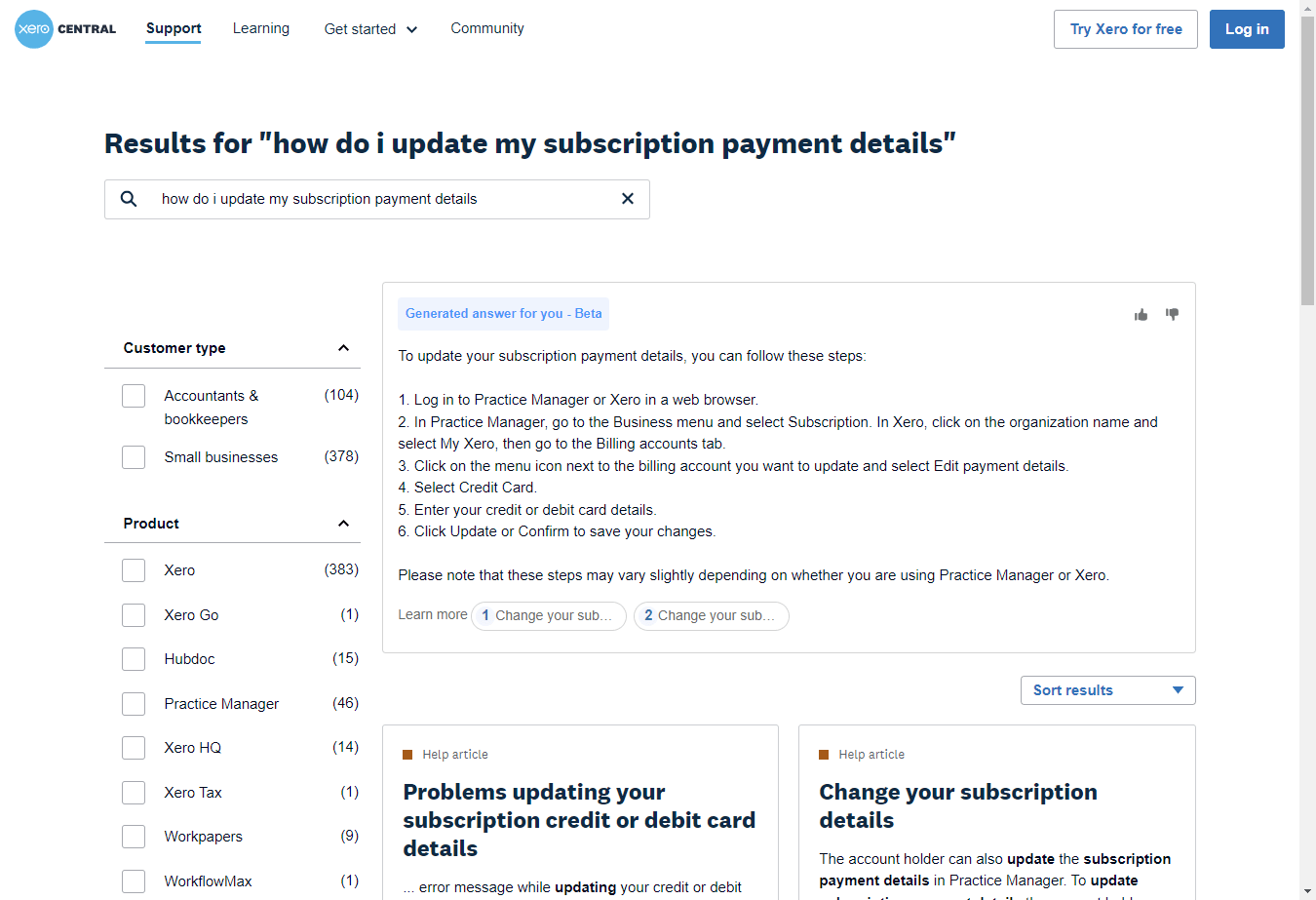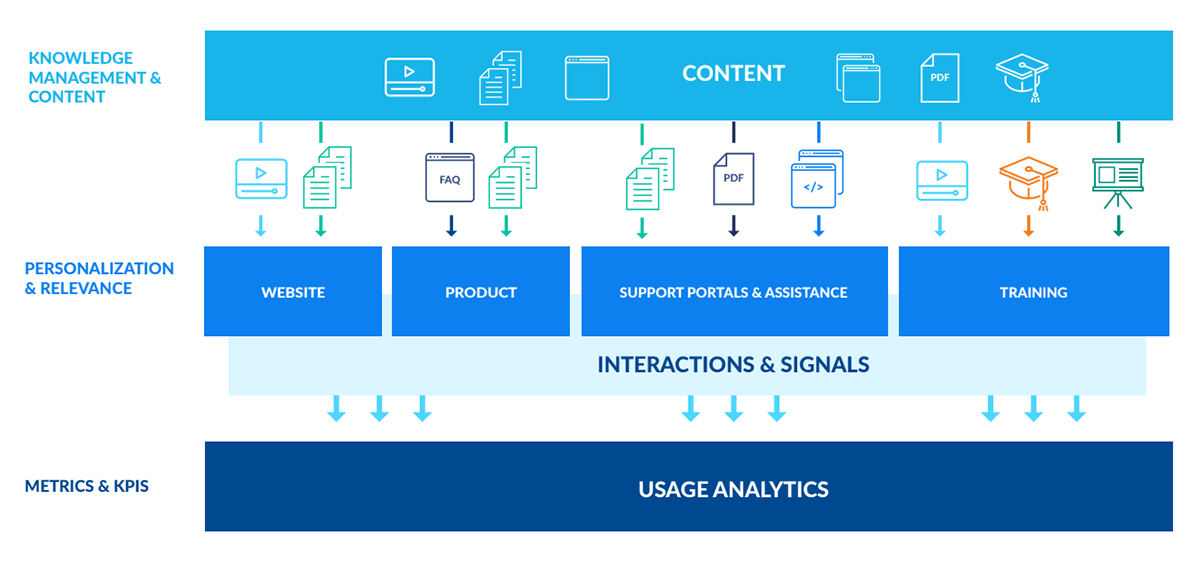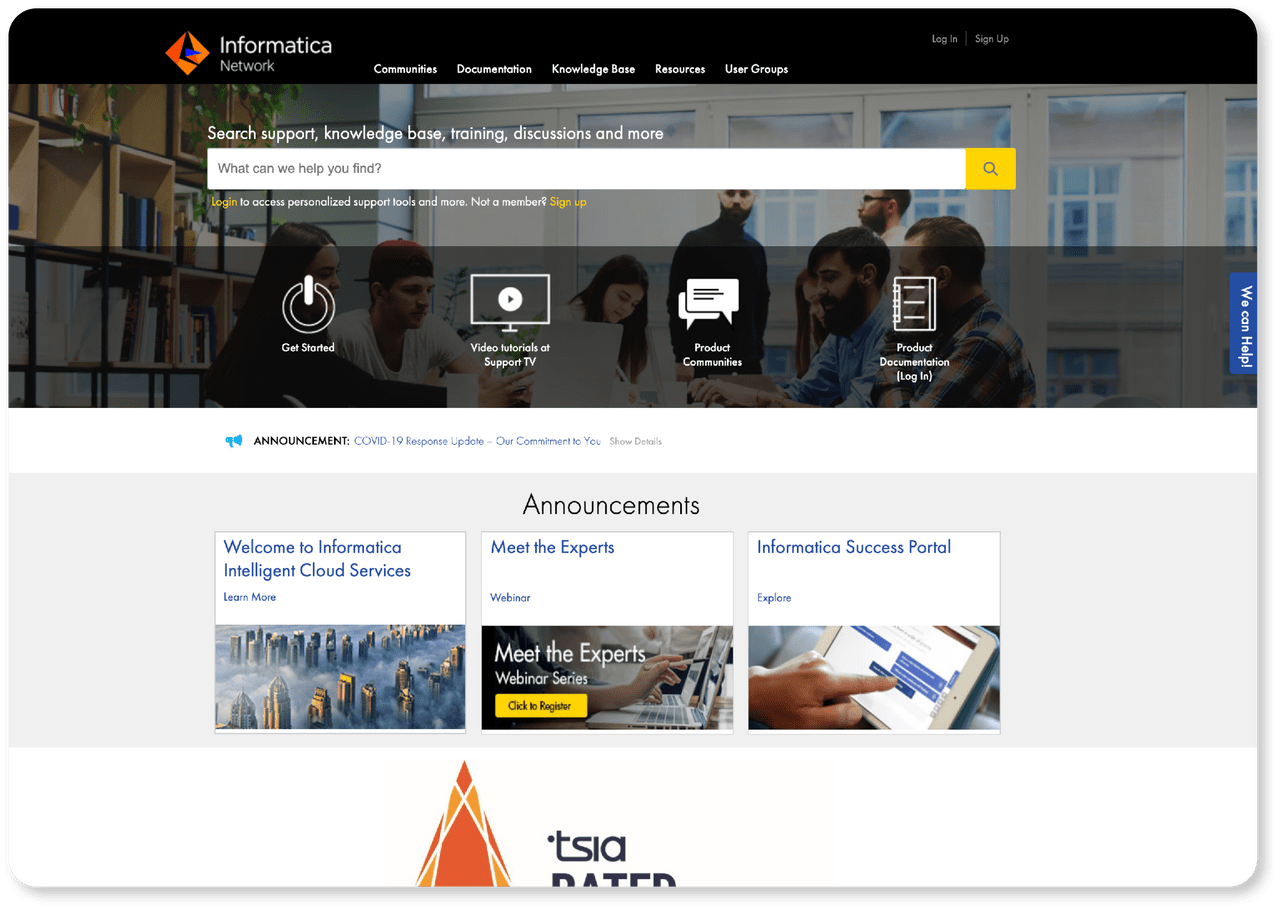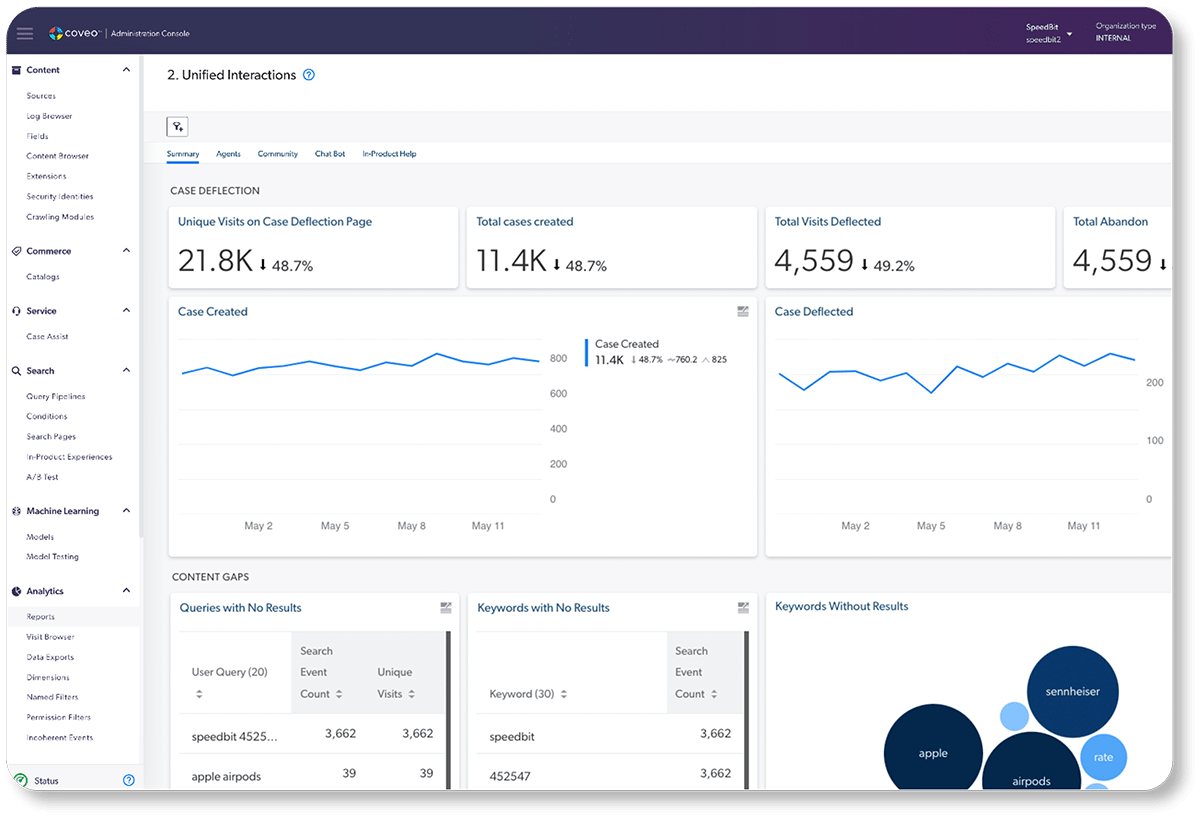Weak self-service experiences weaken customer loyalty. Based on a survey of 4,000 consumers across two countries, a recent Coveo customer experience report found that 72% of customers will abandon a brand’s site after a negative self-service experience.
That could be a prospective customer who’s decided to seek out a competitor. Or an existing customer that won’t return for another purchase. None of which bodes well for customer retention rates, commonly calculated as follows:

How Self-service Affects Customer Retention
Examining customer retention rate makes one thing plain: self-service permeates the whole equation.
There’s a strong tie between self-service, customer satisfaction, and customer churn. Customers who resolve their issues quickly and easily through self-service are more likely to be satisfied with their customer experience. In the long run, they’ll be more likely to continue doing business with the company.
Customers on the receiving end of an AI-powered self-service experience often experience greater satisfaction, as evidenced by Salesforce achieving a +90% self-help success rate through the use of AI.
Beyond getting customers what they need in the moment, be it AI-search enhanced chatbots or knowledge base search, self-service relevance can reduce friction significantly. And this is but one of the ways that strong self-service affects customer retention.
Gives customers what they want
Most customers that you add, keep, or lose will encounter at least one self-service touchpoint along the way. Forty-three percent of customers go straight to the search bar when they land on a website with a specific intent in mind (Coveo CX Relevance Report 2025). And most (61%, according to Salesforce) likely prefer self-service for routine issues.
Saves customers time and effort
Customers can often resolve their issues faster through self-service than they can by contacting a customer service agent. Self-service resources are available 24/7, and the use of machine learning models surfaces the most relevant answers faster.
When customers do need human assistance, AI-powered self-service can make that process more seamless. Self-service (especially when powered by a unified index) allows customers to avoid call transfers, holds, and dead ends.
Lets customers be autonomous
Customers can choose to resolve their issues at their own pace and in a way that is most convenient. They can use the search bar, if preferred, or interact with an AI chatbot.
If they’re looking to learn more about your product, AI-powered recommendations can provide insight into related topics — even ones that might not seem obvious.
Empowers customer support agents
As organizations use AI to automate more and more of the frontline service tier, agents will be left to focus on higher-touch issues. Here, customers demand the same high level of accuracy, relevance, and efficiency.
Look for organizations to rely on the same AI technology they use to automate routine issues to empower their support agents to be more productive. Coveo for Agentforce is a prime example.
Reliable performance indicator
The quality and relevance of self-service experiences has bearing not only on customer retention, but overall performance. Today, 80% of “high-performing service organizations” have some form of self-service solution (Salesforce).
What the online shopping experience can teach us
Online shopping provides some unique insights into how organizations use AI for customer retention. In this highly competitive, fast-moving space, the ability for customers to self-serve can be the difference between repeat purchases and a lost customer.
Unsurprisingly, organizations are using Generative AI (GenAI) to enhance these self-service experiences. A Coveo survey of thousands of online shoppers revealed the many opportunities for AI to enhance the customer experience.

What’s more, entire generations of potential customers expect GenAI to transform their online shopping experience. To acquire, delight, and retain these customers means making good on the promise of AI for customer retention.
Caveat: Only use reliable AI for customer retention
A big part of this promise is relevance and reliability. Expect customer satisfaction and customer retention to suffer when the customers turning to AI-powered self-service encounter AI-powered problems. As it turns out, this happens more often than many organizations would care to admit.
For example, a Coveo survey found that 49% of respondents have experienced a hallucination while using a generative AI tool. Another 42% say they always fact check an AI-generated answer.
Given the close connection between self-service experiences and brand perception — and, by extension, customer retention — no organization wants to make headlines for bad AI. Trust-proofing AI needs to be a priority for any organizations turning to AI for customer retention.
Relevant reading: Putting the ‘R’ in RAG: How Advanced Data Retrieval Turns GenAI Into Enterprise Ready Experiences
5 Self-service Strategies to Help Customer Retention
The prevailing problem is that customers continue to encounter high-effort experiences. And their patience is wearing thin.
Our latest Relevance Report found that, for more than half (53%) of customers, not being able to search for and find info on their own is their biggest self-service hang-up. A far larger percentage (84%) feel they have to put in a moderate to high amount of effort to find info or get help.
For 45%, “finding what I’m looking for in just a few clicks” has the biggest impact on brand perception.
Self-service needs to be part of your customer retention strategy. Here are five strategies to make sure you do it right.

1. Unify access to content sources with a single searchable index
Let’s say a software enterprise needs to maximize case deflection. Their customer service agents are overburdened with the same customer inquiries, such as password resets, account status requests, and the like.
The company has identified their Salesforce Community as the place to handle many of these issues. Customer communities are often the first stop for customers looking to self-serve.
The first step is to bring access to all of the company’s case-deflecting content — all that good customer data stored in SharePoint, file shares, knowledge bases, and even Slack — into a unified search index. That index will power the search bar sitting front and center on every page of the company’s community site, as well as any other self-service channels it might operate.
This hypothetical has concrete, real-world applications. With the help of unified indexing and intelligent content retrieval, Zoom eliminated 89% of content gaps and increased case deflection 2.3x. They also saw a 20% increase in self-service success (with GenAI).
2. Make it effortless for customers and service reps
We’ve established that customers will leave if they can’t find what they need. This creates even greater incentive for service and support professionals to make sure that an active customer only reaches out to support when they absolutely have to.
Self-service helps automate routine tasks, like repeat cases that don’t necessarily require human intervention. Most people will recognize this as case deflection, or the rate at which customers can find their own answers to issues that would have otherwise required a customer support query.
On the other hand, self-service is the rate at which customers can complete a transaction, or answer a question, using site search, community forums, etc.
With a solid self-service offering in place, companies stand to significantly improve customer satisfaction, by reducing the volume of low-touch, repeat cases that routinely overburden contact centers, and ultimately harm customer retention and revenue. This eases the pressure on service reps, helping to alleviate agent burnout and turnover.
What’s good for service reps is typically good for customers.
Informatica is a good example. The data management provider knew that its customers wanted self-service, but found that 20% of searches on the support site were yielding no results. So they invested in unified search and AI-enhanced surfacing, which halved their content gaps, while precipitating a 120% improvement in case deflection.
AI-powered self-service also helped AARP increase case deflection by 62%. For Tableau , self-service-assisted case deflection helps save $1M per month. On the agent’s side of things, self-service helped Medallia’s agents handle 34% more cases on their own, without escalating to the next tier of support.
3. Consider introducing Generative Answering
Generative answering may be just the ticket for helping customers find the answers they need — if this service is implemented with care. Again, you want to make sure you ground the context before passing the relevant snippets or chunks of information to the large language model (LLM).
Coveo Relevance Generative Answering does just that.

Using this process assures:
- Generated answers use your enterprise information to mitigate hallucinations.
- The customer sees only the information they are allowed to see (document permissions).
United Airlines recently implemented Coveo generative answering to improve search functionality. As you’ll see in the following under-the-hood demonstration, generative answering can quickly get customers where they need to go, while avoiding the hiccups that often accompany centralized search experiences.
4. Provide proactive content and search recommendations
When companies can proactively offer contextually relevant information, things go more smoothly for customers.
We’ve seen this exemplified in the impact that personalized recommendations have on service reps helping customers. When service reps don’t have to poke around, but receive AI-powered recommendations within their console view, they’re able to serve customers better.
By doing so, Salesforce support engineers cut their search time by 75%.
Companies have an opportunity to create a similarly personalized experience for customer self-service. For example:
Automatically personalize content recommendations
You can personalize content recommendations based on real-time analysis of customer preferences, site activity, profile information, and other history. For all users, the search bar will actively suggest content as the user types.
For authenticated users, you can deliver more personalized messages based on similar customer behavior, including:
- Product(s) owned
- Support plan
- Geo-location
- Role
- Search query
- Click path
Improve search based on analytics
Use search analytics to continuously improve the experience for both the current customer and to engage prospects. Integrate an analytics engine that shows what content people are engaging with, what’s missing, and other usage patterns.
Are there articles that are deflecting more cases than others? What are the most searched-for terms that have zero search results? This data will help you refine the community experience for your customers, boost customer engagement, and improve the customer relationship overall.
5. Support customer journey mapping
Understanding the customer journey is essential to customer self-service success. An effective way to do so is to build a customer journey map, which details every touchpoint a customer has with your brand.
Given the volume of customer interaction, self-service channels provide a lot of data that can be used in journey mapping. For example, analytics on self-service content can reveal what content particular customers frequently engage with on the way to submitting a case. It can also provide clues as to where customers are hitting dead-ends and bailing.
Here’s an example of a visual customer journey map:

Some organizations begin customer journey mapping by focusing on their self-service portal. In other words, look at a defined audience that you already know a lot about to reveal low-hanging fruit to improve the experience.
Relevant reading: Free Customer Self-Service Journey Map Template
Toward Intelligent Self-Service and Loyal Customers
There are many pressing reasons for prioritizing AI for customer retention. Continued economic uncertainty and evolving workplace environments, for example. One of the most effective ways to show both existing and new customers that they’re valued is to help them help themselves.
A strong self-service offering, one rooted in data-driven insights and personalization, can pay tremendous dividends, both qualitative and quantitative. Just ask Zoom, Salesforce, and the other companies whose self-service initiatives play a critical role in retaining customers.
What these and other companies understand is that self-service is critical to a scalable support organization that promotes customer success. By some accounts, new developments within the AI for customer retention space — agentic AI, namely — promise to dramatically reshape the future of customer experience altogether.
To make sure your organization is ready to continue meeting customer needs, see our Guide to Delivering Intelligent Self-Service, which includes seven best practices for AI driven personalization, based on real-world examples.
Dig Deeper
Did you know that when asked what would improve self-service, 51% of customers said they want to see the answer directly within search results — not buried in a help article? And that 53% of all respondents identified “not being able to easily search for and find the information I’m looking for” as the #1 problem in their self-service experience?
Read the 2025 Customer Experience Relevance Report for these and other insights that will help you improve your customer retention strategy, brand loyalty, and overall customer value.




